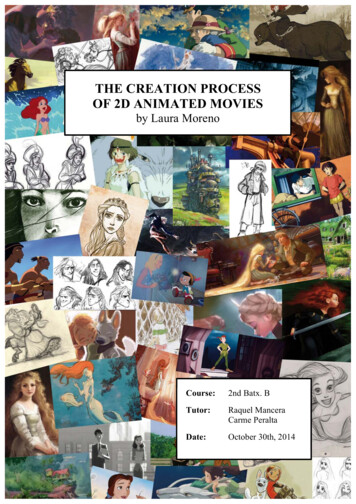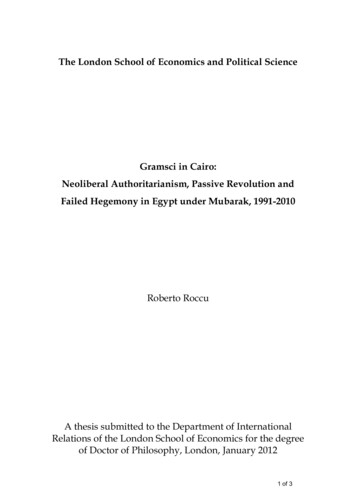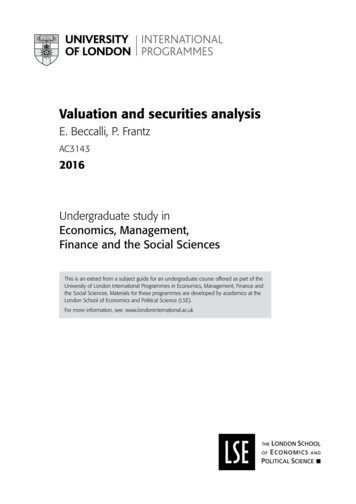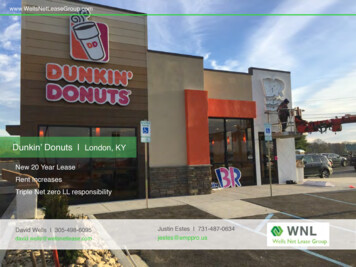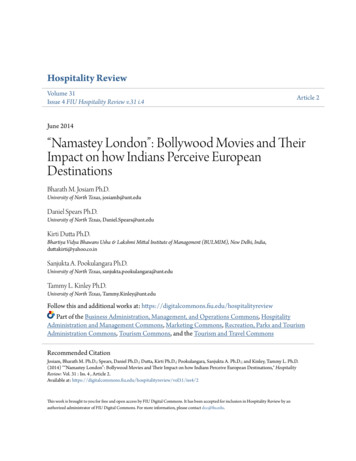
Transcription
Hospitality ReviewVolume 31Issue 4 FIU Hospitality Review v.31 i.4Article 2June 2014“Namastey London”: Bollywood Movies and TheirImpact on how Indians Perceive EuropeanDestinationsBharath M. Josiam Ph.D.University of North Texas, josiamb@unt.eduDaniel Spears Ph.D.University of North Texas, Daniel.Spears@unt.eduKirti Dutta Ph.D.Bhartiya Vidya Bhawans Usha & Lakshmi Mittal Institute of Management (BULMIM), New Delhi, India,duttakirti@yahoo.co.inSanjukta A. Pookulangara Ph.D.University of North Texas, sanjukta.pookulangara@unt.eduTammy L. Kinley Ph.D.University of North Texas, Tammy.Kinley@unt.eduFollow this and additional works at: rt of the Business Administration, Management, and Operations Commons, HospitalityAdministration and Management Commons, Marketing Commons, Recreation, Parks and TourismAdministration Commons, Tourism Commons, and the Tourism and Travel CommonsRecommended CitationJosiam, Bharath M. Ph.D.; Spears, Daniel Ph.D.; Dutta, Kirti Ph.D.; Pookulangara, Sanjukta A. Ph.D.; and Kinley, Tammy L. Ph.D.(2014) "“Namastey London”: Bollywood Movies and Their Impact on how Indians Perceive European Destinations," HospitalityReview: Vol. 31 : Iss. 4 , Article 2.Available at: ol31/iss4/2This work is brought to you for free and open access by FIU Digital Commons. It has been accepted for inclusion in Hospitality Review by anauthorized administrator of FIU Digital Commons. For more information, please contact dcc@fiu.edu.
“Namastey London”: Bollywood Movies and Their Impact on howIndians Perceive European DestinationsAbstractThe aim of this study is to analyze the perception of European destinations through the eyes of IndianBollywood film viewers to determine how perception is influenced by what is viewed in films. Researcherssurveyed Indian consumers and collected 670 usable surveys. European destinations were divided into topfive and bottom five destinations for Indian tourists, and data was then compared to world tourism statistics.Results indicate differences in destination preference among Bollywood viewers and worldwide tourist trends.Findings indicate that prominently featuring a landscape within Bollywood films can significantly impactIndians’ perception on the destinations’ image. European countries frequently portrayed in films have highermarks on multiple perception categories than those not featured in blockbuster Bollywood films.KeywordsBollywood Movies, European Destinations, Indian Tourists, Movie Induced Tourism, Travel Motivations,Destination MarketingThis article is available in Hospitality Review: ol31/iss4/2
“Namastey London”: Bollywood Movies and Their Impact on howIndians Perceive European DestinationsIntroductionBollywood films are making waves across the international stage, not only withtheir perfectly synchronized dancing, but also in their depiction of Indian travelbehaviors. This industry is one of the largest film industries in the world,producing over 1,000 movies every year. It is a 72 billion industry selling sixbillion tickets annually (Desai, 2005; Lovgren, 2004; Minocha & Stonehouse,2006). Its commercial size grew at the robust rate of 58% in the five year periodbetween 2001 and 2005 (Lorenzen & Täube, 2008). Film exports also expanded30–50% year on year during the same period and were forecast to increase by afurther 20% to 2010 (2008). A large chunk of this movie output from India comesfrom the city of Mumbai, formerly known as Bombay. Hence, the moniker ofBollywood was given to the Indian film Industry.As a rapidly developing country, India has seen tremendous growth in its300 million strong middle class (Rempel, 2007) and their purchasing power in thepast two decades. This growth boom has impacted all sectors of the Indianeconomy, including outbound international tourism. The combination of theseforces has created an opportunity for growth in overseas tourism destinations,often influenced by Indians’ perception of Bollywood films. A noteworthy pieceof evidence of the Indian market potential is the recent surge of Indian tourists toSpain after the release of the Bollywood film – Zindagi Na Milegi Dobara, setagainst a Spanish backdrop (Harjani, 2011). Six months after its showing, theSpanish tourism board saw a 32% upswing of visitors from India to Spain(Harjani, 2011). Similarly, Mr. Yash Chopra, a major producer/director ofBollywood movies, idealized Switzerland as a romantic destination in his filmsand subsequently caused an increase in outbound travel from India to Switzerland,increasing the outbound travel from India by 30% (Dubey, 2008). With theproliferating number of consumers of Bollywood films, destination marketers areeager to capitalize on this crown jewel of the Asian market.Evoking positive perceptions of the destination through imagepresentations has become an effective way to catapult the target destination intothe tourist’s consideration set. Images of film locations affect the audience’sselection of one destination over another and their subsequent behaviors in thedestination (Bandyopadhyay, 2008; Han & Lee, 2008; Young & Young, 2008;Kim & O’Connor, 2011). Not surprisingly, the tourists who travel to a placedepicted in a movie arrive with expectations and images about the location similarto what is shown on screen (Butler, 2011). The images of the film thus affectsome destination image components and heighten tourists’ interest in visiting
(Kim & Richardson, 2003). Beverley and Niki (2009) suggested that mediainduced tourism helps tourists fulfill fantasies of being in the films via thevicarious experience of actually traveling to the sites where they were filmed.Tsiotsou and Ratten (2010) advocated that tourism marketers should heedgeneral shifts in the population in order to identify the changing habits anddemands of tourists. A number of convergent trends make it imperative to studythe Indian outbound tourism market. First, with its swelling 300 million plusmiddle class (Rempel, 2007), India has become an important member of theglobal consumer market. Second, there has been a tremendous growth ofoutbound international tourism from India, which is expected to continue foryears to come. Millions of Indians now not only aspire to travel abroad, butactually possess the means to do so. Third, the size and scale of the multi-billiondollar Bollywood movie industry, and its role in filming movies in Europe, thusshowcasing international destinations to Indians for decades, is now enablingIndians to move from the fantasy world of films to the real world of travel tofeatured destinations. Given the potential growth of Bollywood and its growingclout on the Indian audience, a close look at their perceptions of Europeandestinations, as seen through Bollywood films, will help open the door ofEuropean tourism wider for the Indian market. The purpose of this paper, thus, isto investigate the profiles of Indian film viewers and their perceptions of majorEuropean destinations through the images of Bollywood cinema. The in-depthanalysis of this growing segment can help destination marketers gain insight intothe travel needs of this growing middle class Indian market.ObjectivesThe objectives of this study are:1. To determine the demographic profile of Indians who watch Bollywoodmovies.2. To determine Indians’ engagement with Bollywood movies.3. To explore the linkage between Bollywood movies and select traveldestinations in Europe.4. To determine perceived images of European countries as destinations, andthe attractions and activities they present to tourists.Literature reviewFilm-induced tourismFilm tourism is defined as “tourist visit to a destination or attraction as a result ofthe destination’s being featured on television, video, or the cinema screen”
(Hudson & Ritchie, 2006b: p. 387). Evidence from around the world affirms thattourists are increasingly visiting destinations as a result of those places beingdepicted or featured in film or television (Connell, 2005; Im & Chon, 2008;Iwashita, 2008). “Destinations, landscapes, events and their contained cultures canbe significant factors in the communication of tourism” (Crouch, 2007: p.72).Films not only influence destination choice, but also impact the tourism industry.“Film-induced tourism is partially based on tourist demands to escape reality to abetter world represented in films” (O’Connor et al., 2008: p. 434). This makes itimportant for destination marketers to carefully craft their role in the filmingprocess in order to portray an image that best reflects the location.Motivations for traveling to screened locationsGenerating interest in a destination is key to increasing visitation. Films can act asa means of marketing a destination to millions of viewers. Mannell and Iso-Ahola(1987) identified two motivational forces or dimensions of escaping and seekingthat operate simultaneously to stimulate and result in tourist behavior. Anindividual’s travel behavior is influenced by the desire to escape from one’sroutine personal and/or interpersonal environment while seeking rewardingpersonal and/or interpersonal experiences (Iso-Ahola, 1983). Furthermore,according to Maconis (2004), the two primary motivators for traveling to screenedlocations are novelty and fantasy.Hudson and Ritchie (2006b) indicated that 8 of 10 residents of the UnitedKingdom remarked in a 2004 survey that they got the idea for their vacationdestination through movies, and 1 in 5 is planning a trip to the location theirfavorite movie was filmed. Suni and Komppula (2012) have asserted that movieinduced tourism in United Kingdom is worth about 1.6 billion pounds. Though noestablished methods yet exist to measure film-induced tourism, film influences ontourism are evident in the increase in visitor numbers after a movie has beenreleased (Singh & Best, 2004). Their study followed the film-induced tourismprompted by the release of the Lord of the Rings trilogy. The authors found thatthe main motivation to visit Hobbiton (movie set/backdrop) was to experience thenatural scenery of that place. This indicated that travelers motivated by a movieexpect to see the views/sceneries as shown in the movie. After the release of theLord of the Rings trilogy, marketing material produced by Tourism New Zealandwas created connecting locations from the films to the scenery of New Zealand,displaying a documented effect on how movies can impact tourism (Croy, 2004;Macionis & O'Connor, 2011; Suni & Komppula, 2012).New Zealand, a film-friendly destination, is a prime example of a placethat has successfully collaborated and leveraged off the success of The Lord ofthe Rings trilogy. Industry integration and collaboration between stakeholders is
crucial for sustainable film-induced tourism to occur. The tourism and filmstakeholders should work closely with each other to help promote theirdestination tourism and marketing strategies as well as their productdifferentiation more effectively.Movies seen and places visitedThe tourism literature is replete with studies that identify specific movies and thenexamine how they have induced tourism to destinations worldwide. O’Connor, etal. (2008), have studied the relationship between film induced tourism anddestination branding of Yorkshire in the UK. Frost (2010) has studied the impactsof movies on the Australian outback on tourist perceptions. Im and Chon (2008)studied the long-felt impact of the classic musical – The Sound of Music ontourism to Salzburg, Austria. Frost (2006) has studied the impact of the historicalfilm – Braveheart and its’ impact on the destination image of Scotland, UK.Iwashita (2008) has examined how Japanese tourists to UK are motivated by filmsand television dramas. O’Connor (2011) has examined film-induced tourism toIreland.In addition to studies on movie-induced tourism to UK and Australia,scholars have also studied how Korean TV dramas have attracted tourists from theMiddle-East to Korea (Kim, et al., 2009); while Shani (2009) and Hudson, et al.(2011) have both studied the impact of movies on tourism to and image of SouthAmerica. Soliman (2011) has examined the impact of movies on domestic tourismwithin Egypt; and Law, et al. (2007) have critically examined the role of foreigntourists in Thailand.In summary, this section of the literature has shown the impact thatmovies have had on increasing tourism to the locations shown. Furthermore, it isnoteworthy that the studies cited earlier show evidence of movie-induced tourismworld-wide in Asia, Continental Europe, the Middle-East, South America, and theUK.Bollywood films and tourismIn the 1950s, 1960s, and 1970s, romantic sequences in Indian films wereprimarily shot in the mountainous region of Kashmir in India, widely regarded as'heaven on earth'. Bollywood directors were mesmerized by the beauty ofKashmir, so much so that the mountains in Kashmir became synonymous withromance in Bollywood. However, when the terrorism threats of the late 1980smade the region difficult to reach, and later inaccessible, Bollywood directors
began seeking substitute locations overseas (Macionis, 2004; Macionis & Sparks,2008).Fascination with foreign locations within Bollywood began in the mid1960s when Raj Kapoor (Bollywood Producer/Director/Actor) shot his first colorfilm, titled Sangam, in Italy, France, and Switzerland. This started the foreignlocations trend in Indian cinema. The trend accelerated in the 1970s to 1990swhen actors were transported to striking foreign locations like the Swiss Alps andBritain’s Summer Isles, which were the primary backdrops of many Yash Chopraproductions (Shah, 2012). More than 200 Bollywood titles have been shot inSwitzerland over the past two decades alone (“Bollywood drives ,” 2008).“Most of the Swiss sequences are dream scenes in which lovers dance or romp onAlpine meadows strewn wit
scholars have also studied how Korean TV dramas have attracted tourists from the Middle-East to Korea (Kim, et al., 2009); while Shani (2009) and Hudson, et al. (2011) have both studied the impact of movies on tourism to and image of South America. Soliman (2011) has examined the impact of movies on domestic tourism



